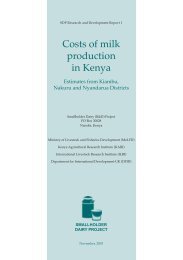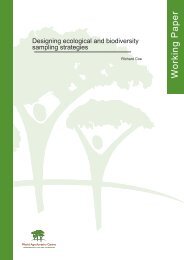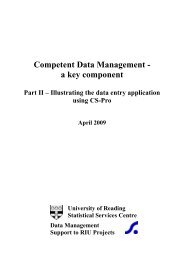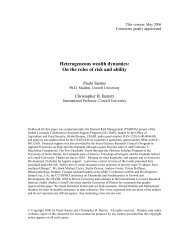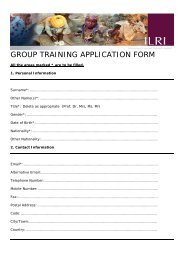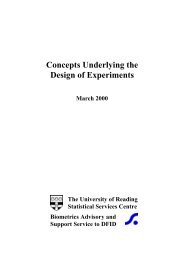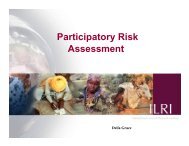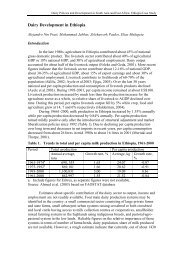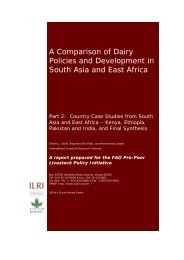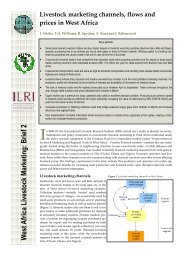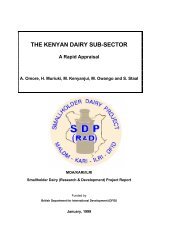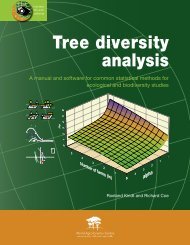Improvement of Livestock Production in Crop-Animal Systems in ...
Improvement of Livestock Production in Crop-Animal Systems in ...
Improvement of Livestock Production in Crop-Animal Systems in ...
Create successful ePaper yourself
Turn your PDF publications into a flip-book with our unique Google optimized e-Paper software.
otations are practised, and there appears to be little <strong>in</strong>ter-cropp<strong>in</strong>g, relay-cropp<strong>in</strong>g or sequential-cropp<strong>in</strong>g.An earlier ley farm<strong>in</strong>g project did not result <strong>in</strong> the successful adoption <strong>of</strong> leys <strong>in</strong> the region because <strong>of</strong> eithercompetition with crops or, <strong>in</strong> some cases, a reluctance on the part <strong>of</strong> farmers to plough <strong>in</strong> the ley andre-establish a crop. On some <strong>of</strong> the dairy farms around the city <strong>of</strong> Khon Kaen, the total farm area is sown topasture, with fruit trees grown around the house. Nevertheless, there is an <strong>in</strong>creas<strong>in</strong>g trend towards cropdiversification, with vegetables, ornamentals and mango be<strong>in</strong>g established.The other three regions (northern, central and southern) lie at latitudes 6–20° North. The northern regionreceives an average <strong>of</strong> 1500 mm ra<strong>in</strong>fall annually. The central region receives an average <strong>of</strong> 1300 mm ra<strong>in</strong>fallannually and is located <strong>in</strong> the fertile Chao Phaya River Bas<strong>in</strong>, one <strong>of</strong> the richest rice areas <strong>in</strong> the world. Thesouthern region is a major crop production area receiv<strong>in</strong>g 2100–4725 mm ra<strong>in</strong>fall. Soils <strong>in</strong>clude alluviums,clays, sandy loams and clay loams.The greatest areas <strong>of</strong> land under plantation crops are <strong>in</strong> the southern region where some 90% <strong>of</strong> therubber, 100% <strong>of</strong> oil palm and coconut, and 23% <strong>of</strong> the fruit trees are grown (Sophanodora and Tudsri 1991).Rubber is the most important tree crop <strong>in</strong> terms <strong>of</strong> total plantation area (approximately 1.7 million ha out <strong>of</strong>about 2.6 million ha) and <strong>in</strong> its contribution to the economy. Although not all <strong>of</strong> the plantations are suitablefor the <strong>in</strong>tegration <strong>of</strong> animals, they represent a significant area for potential livestock production <strong>in</strong> commonwith other countries <strong>in</strong> the ASEAN sub-region. The majority <strong>of</strong> rubber hold<strong>in</strong>gs are 500 ha. Coconut plantations are also small <strong>in</strong> terms <strong>of</strong> size.<strong>Animal</strong> resourcesThe north-east region is a major area for animal production, with the highest populations <strong>of</strong> large rum<strong>in</strong>ants<strong>of</strong> the four regions and the greatest amount <strong>of</strong> graz<strong>in</strong>g and wasteland. <strong>Animal</strong>s contribute 34% to farm <strong>in</strong>come<strong>in</strong> the north-east region compared to 18, 25 and 31%, respectively, for the northern, central and southernregions. The sub-sector is expected to develop further <strong>in</strong> the future. There are also significant numbers <strong>of</strong>non-rum<strong>in</strong>ants <strong>in</strong> the region. Smallholder crop–animal systems are be<strong>in</strong>g targeted by the government <strong>in</strong> aneffort to improve farmer <strong>in</strong>come, and <strong>in</strong>creases <strong>in</strong> the numbers <strong>of</strong> dairy and beef animals <strong>in</strong> the region areanticipated <strong>in</strong> the next five years, with decreases <strong>in</strong> the size <strong>of</strong> the rice- and cassava-grow<strong>in</strong>g areas.The region is endowed with relatively large numbers <strong>of</strong> buffaloes, cattle, pigs and poultry,approximat<strong>in</strong>g to about 36, 76, 26 and 31%, respectively, <strong>of</strong> the total national populations. <strong>Animal</strong>s havemultiple uses. Buffaloes are kept for traction, meat and manure. Buffaloes produce more manure than cattle;4.75% versus 3.16% <strong>of</strong> body weight, and the manure is higher <strong>in</strong> nitrogen and phosphorus content but lower<strong>in</strong> potassium. Cattle are kept for meat, milk and manure, and Brahman and Friesian crossbreds are available.Large numbers <strong>of</strong> goats (80%) are raised <strong>in</strong> the southern region, many <strong>in</strong> plantations (especially coconut),although no statistics appear to be available on actual populations. The goats are similar to the Katjang goats<strong>of</strong> Malaysia and Indonesia, whilst the sheep are long-tailed and hairy, and were <strong>in</strong>troduced by traders fromthe north via the silk road. In recent years, both goats and sheep have been exported to Malaysia and elsewherefor meat as well as for breed<strong>in</strong>g.Pigs are important amongst smallholders for meat, and are based on exotic breeds. Poultry also providemeat. There is no <strong>of</strong>ficial importation <strong>of</strong> cattle from Australia for beef production, as <strong>in</strong> the other countriesvisited. However, a clandest<strong>in</strong>e trade <strong>in</strong> live animals occurs with Myanmar and the Lao PDR, for which thereare no statistics.The government, through the Sur<strong>in</strong> <strong>Livestock</strong> Breed<strong>in</strong>g Station, cont<strong>in</strong>ues to support breed<strong>in</strong>gprogrammes for buffaloes <strong>in</strong> order to improve the draft capability and meat production <strong>of</strong> the exist<strong>in</strong>g stock.As part <strong>of</strong> its extension effort, the station has a loan programme whereby improved male buffaloes are usedto upgrade the animals <strong>of</strong> co-operative farmers <strong>in</strong> selected communities.<strong>Animal</strong> production systemsSmallholders are primarily <strong>in</strong>volved <strong>in</strong> the production <strong>of</strong> buffaloes, beef cattle and non-rum<strong>in</strong>ants <strong>in</strong>essentially mixed subsistence systems, where low <strong>in</strong>puts are used for the production <strong>of</strong> rice, cassava andsugar-cane. In the northern region <strong>of</strong> Thailand, both cattle and buffaloes graze under tree crops (tea, c<strong>of</strong>fee



